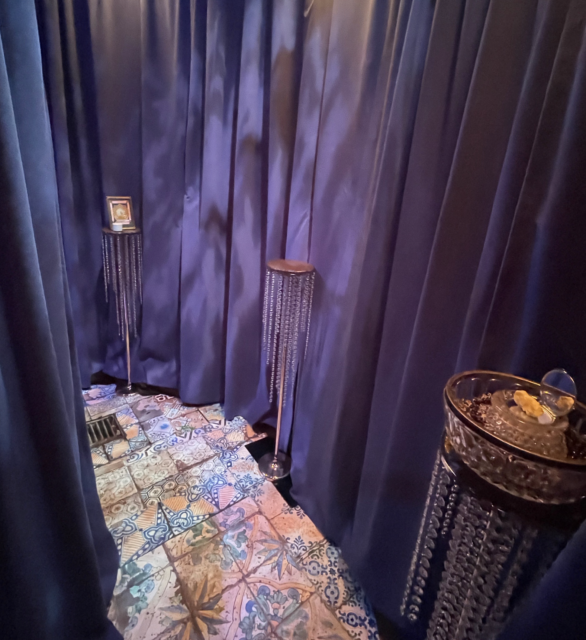
The Story of Lot’s Wife celebrates a never-named but key biblical character (photo by twi-ny/mdr)
THE STORY OF LOT’S WIFE
The Cell Theatre
338 Twenty-Third St. between Eighth & Ninth Aves.
Thursday – Sunday through August 25, $10-$35, 11:00 am – 7:00 pm
www.thecelltheatre.org
www.ofotheater.com
Dan Daly reimagines a mysterious figure from the Bible in the immersive, performerless theater installation The Story of Lot’s Wife, extended at the Cell through August 25.
Described as “a recentering through text, object, and action,” the fifteen-minute ritualistic but not religious experience gives agency and identity to Lot’s wife, who is never named in the Bible, neither in the Old Testament nor in the New Testament, where Jesus declares as a warning, “Remember Lot’s wife.”
The narrative is divided into ten sections, beginning with a prologue that relates the tale of Lot, his wife, and their daughters as two angels descend from heaven to save them from the rampant sin occurring in Sodom and Gomorrah. As they leave the burning city, Lot’s wife looks back at the devastation and becomes a pillar of salt.
After reading the account, one audience member at a time then enters a small, narrow winding structure, walking through a beaded curtain and along a tiled path lined by fragile blue velvet, stopping at nine stations to read from a handout and examine a related object on a plinth. (Daly conceived the project during the pandemic, when theaters were closed and people were not interacting with one another.) Among the items are Himalayan salt, a bar napkin, a piece of brimstone, and a framed icon, accompanied in the booklet by a brief description and a photo of a related object from the real world. An atmospheric soundscape by Julian Singer-Corbin echoes through the space, which is dimly lit by Zoe Griffith.
Daly, who wrote the text and designed and constructed the installation, seizes on the word “became.” At the second stop, the narrative explains: “The story says, / ‘and she became a pillar of salt.’ / You were not turned, you became. / It follows that a choice was made to become, / To preserve, / To remember the people you love. / When you ‘become’ you have a will, / To become is not forced upon you, it is an action.”
Daly proposes that it was not divine intervention but her own tears that changed Lot’s wife’s body into salt. He also sees her as a gay icon, suggesting that what she was looking back at was, at least in part, a homosexual community that was not involved in debasement but in same-sex love; he acknowledges that queerness never factored specifically in the biblical tale, but he writes, “We welcome the name ‘Sodomites’ with honor.” As of late 2023, twelve states still had laws against consensual sodomy, or gay sex. The play concludes with a communal call for renewal.
The Story of Lot’s Wife is presented through the new company Other Forms of Theater (Ofo), which seeks to “create and support performances that do not fit neatly into the definition of ‘theatre’ and exist below what is deemed commercially viable. We experiment with the theatrical form and rethink what performance is, not just artistically but also structurally.”
Daly, who has designed such shows as the immersive Tammany Hall at SoHo Playhouse and Third Rail Project’s site-specific Oasis at Brookfield Place, has accomplished just that with The Story of Lot’s Wife, which is about a lot more than a biblical yarn. On your way out, be sure to say hello to the person behind the desk and share your thoughts; it’s likely to be Daly himself.
[Mark Rifkin is a Brooklyn-born, Manhattan-based writer and editor; you can follow him on Substack here.]